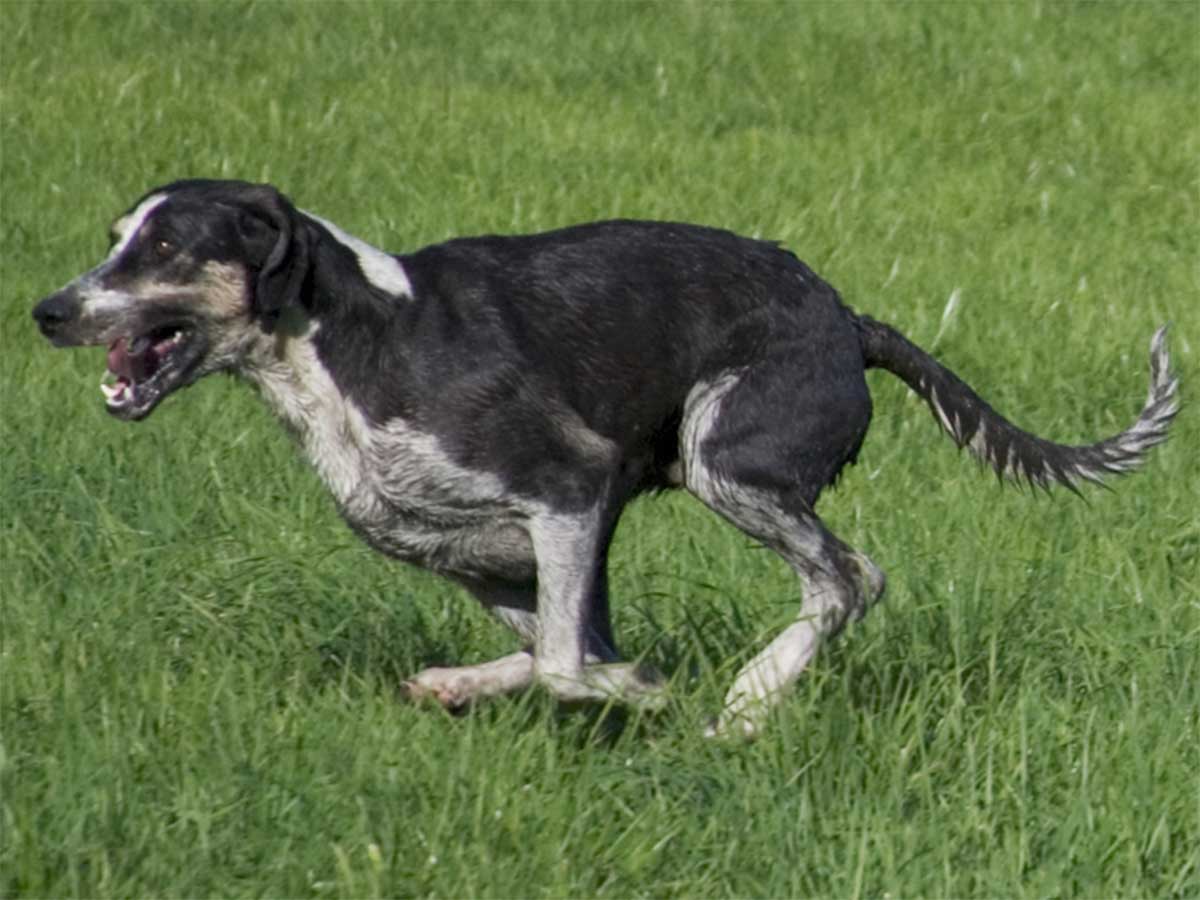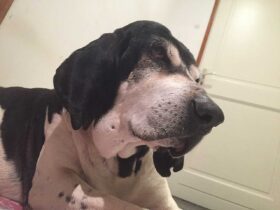Content |
|---|
History
This breed is originally from the "Bâtard Anglo - Saintongeois" a species that emerged in the mid-nineteenth century and was the result of the cross between the Gascon Saintongeois and the English Foxhound. Currently the breed has approximately 2000 specimens with approximately 200 births per year. They form a group of 20 or more deer hunters and a deer hunter.
The text of the year 2007 was written by M. Pierre Astié, President of the "Club du Chien d'ordre" and its committee in collaboration with Mr..
Raymond Triquet. –
Physical Characteristics Black and White Great Anglo-French Hound
The Great Anglo-French White and Black Hound is a big dog, pretty powerful, resilient and robust with strong bones that recall its origins with the Gascon Saintongeois. Its ears are medium-length. Extended forward, reach at most the snout two fingers behind the nose. Rather they end up at one point. Strong at birth, its tail ends at a conical point, long and straight; above the line of the back when the dog is in action but not reaching the vertical.
He has short hair, pretty strong and tight, necessarily black and white, with a large fur and more or less extensive black spots, which may show black or bluish spots, or even small tan marks, but these only in the limbs. A pale tanned spot over each eye and a pale tan on the cheeks, under the eyes, under the ears and at the base of the tail”. The “deer mark” on the thigh is quite common.
CARVING:
– Males: 65 to 72 cm.
– females: 62 to 68 cm.
Weight: On 25 kg.
Character and skills Great Anglo-French White and Black Hound
The Great Anglo-French White and Black Hound lives mainly in packs and kennels. Used for deer hunting, roe deer or wild boars. Hunting on any terrain, even wet or wooded. The Great Anglo-French White and Black Hound form packs of about twenty dogs on hunts in their country of origin, France. You can also hunt alone with your master.
For a companion dog, the field and a large fenced garden are preferable. An accomplished athlete, the Great Anglo-French White and Black Hound will delight a good runner. In the presence of young children, it is not advisable to adopt an adult kennel dog without making sure it has been well socialized with children.
Health Great Anglo-French White and Black Hound
Like all large races, the great black-and-white Anglo-French can suffer from joint pain. Their soft ears are sometimes prone to ear infections..
Hunting accidents are common and cause injuries, fractures or sprains.
Groomed Great Anglo-French White and Black Hound
The short coat of the Great Anglo-French White and Black Hound should be brushed once a week.
Returning from the hunt, the fur will be inspected for wounds, parasites or thorns. Good vaccination and pest control coverage is recommended.
Great black and white Anglo-French hound training
The Great Anglo-French White and Black Hound he is friendly, but with a strong character. You'll have to be politely educated.
as a companion dog, it is preferable to bring a puppy that can be raised and socialized. Dog hunting training will be conducted by a hunter.
Exercise Great Anglo-French White and Black Hound
The Great Anglo-French White and Black Hound is an extremely vigorous working dog, accustomed to very intense physical exercise. When not hunting, he must be given the opportunity to expend his excessive energy. This dog is an infamous cat hunter, so it should never be released without a leash until it is in a closed and secure area.
During the hunting season it is advisable to offer the dog some type of exercise that emulates its hunting behavior.. It is worth remembering that if the Great Anglo-French White and Black Hound lacks opportunities to vent, will gradually turn into a rebellious animal, hyperactive and destructive.
Videos "Great Anglo-French White and Black Hound"
|
Grand Anglo Français Blanc et Noir ?? Everything Dog Breeds ??
|
HTTPS://youtu.be/sPQufNrtDwA
Grand Anglo Francais Blanc et Noir Dog Breed
|
|---|
Type and recognitions:
- FCI CLASSIFICATION: 323
- Group 6: Scent hounds, and related breeds.
- Section 1.1: Large-sized hound-type dogs.. With proof of work..
Federations:
- – FCI – Group 6: Scent hounds, and related breeds. – Section 1.1: Large-sized Hounds. ⓘ
- – Central Canine Society ⓘ
FCI breed standard "Great Anglo-French White and Black Hound"
Alternative names:
1. Grand Anglo-Français Blanc et Noir (English).
2. Grand Anglo-Français Blanc et Noir (French).
3. Grand Anglo-Français, Grand anglo-français blanc et noir (German).
4. Grand anglo-français blanc et noir (Portuguese).
5. Grand anglo-français blanc et noir (español).
Photos:
1 – A Grand Anglo-Fancais blanc et noir at full gallop by Alephalpha, CC BY-SA 3.0, via Wikimedia Commons
2 – Anglo-French white and black face by ArnaudM63, CC BY-SA 4.0

